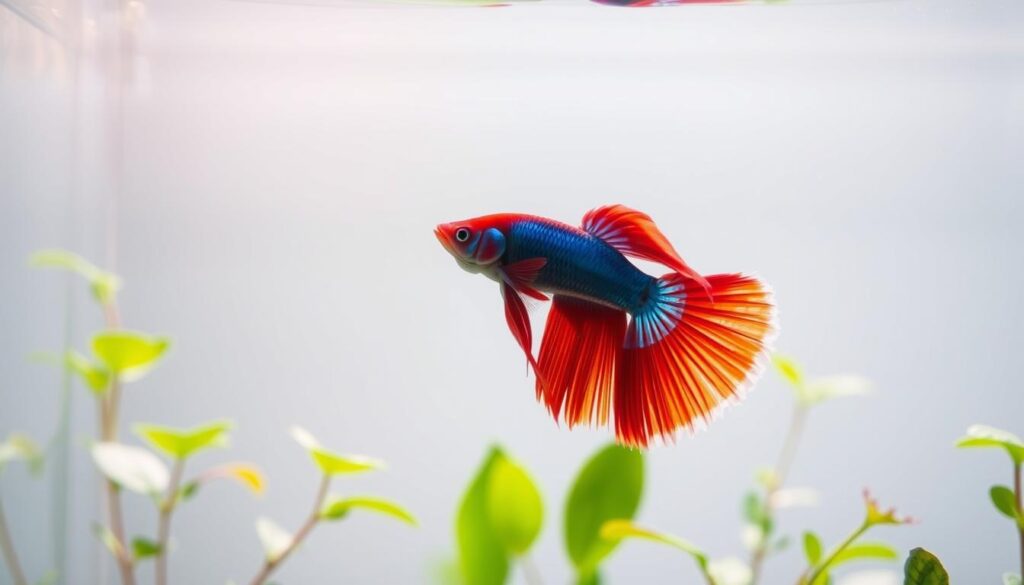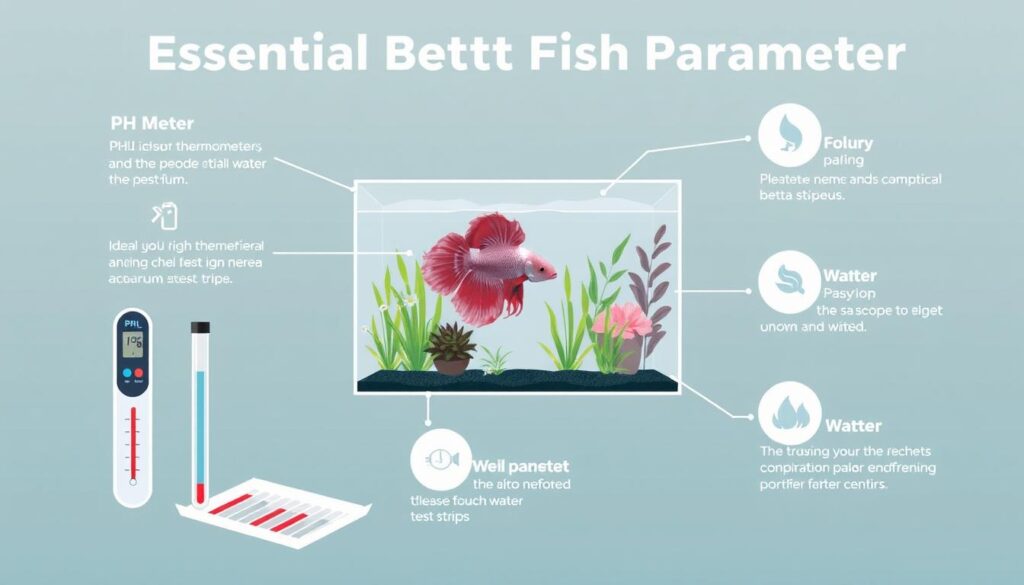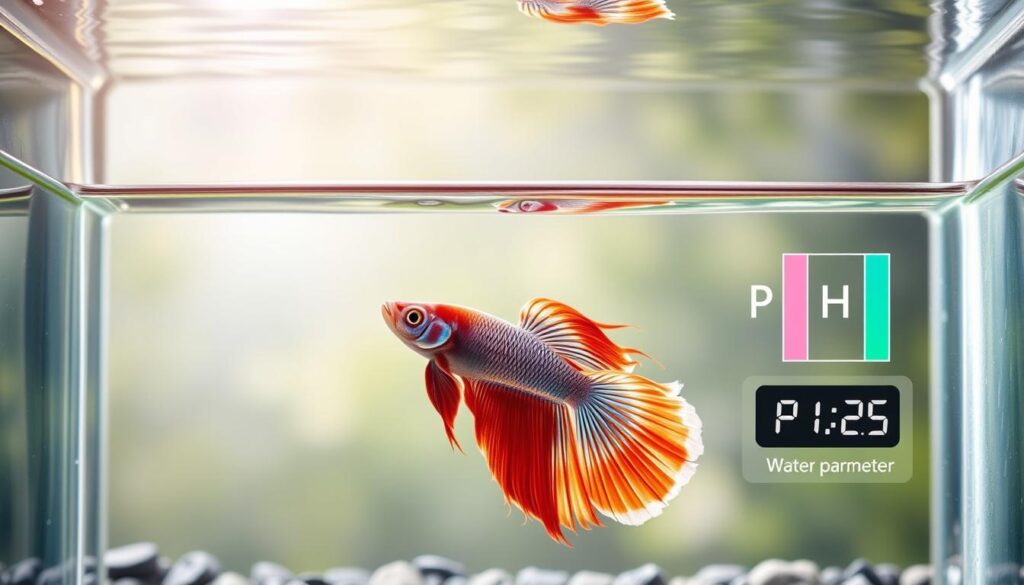Keeping your betta fish healthy and stress-free starts with one simple thing: perfect water conditions. Whether you’re a new fish keeper or a seasoned aquarist, understanding betta fish water parameters is absolutely crucial. These beautiful, colorful fish may look hardy, but poor water quality can quickly lead to illness or even death.
Key Takeaways
- Understand the importance of optimal tank conditions for your betta’s health.
- Learn how to create a thriving environment for your betta.
- Discover the key factors to consider when setting up your betta’s tank.
- Get tips on maintaining the right conditions for your betta to flourish.
- Find out how to keep your betta happy and healthy.
Understanding the Natural Habitat of Betta Fish
Imagine creating a warm, slow-moving water environment in your home aquarium, just like Southeast Asia’s rice paddies and shallow waters. Betta fish come from these areas, where the water is warm and full of hiding spots. To keep your Betta happy, it’s key to mimic these natural conditions.
Rice Paddies and Shallow Waters of Southeast Asia
Betta fish love environments with lots of plants and slow water. These conditions give them shelter and help keep the water quality right. In their natural home, Bettas are used to warm temperatures and high humidity.
| Characteristics | Natural Habitat | Ideal Tank Conditions |
|---|---|---|
| Water Temperature | 78-80°F | 78-80°F |
| Water Movement | Slow | Low to Moderate |
| Vegetation | Abundant | Plenty of Plants |
Why Natural Conditions Matter for Captive Bettas
Creating a natural habitat in your Betta tank is crucial for their health. By meeting thebetta fish tank water requirements, you can avoid stress and disease. This means keeping the water at the right temperature, pH levels, and providing enough hiding spots.
The Importance of Proper Water Quality for Betta Health
Good water quality is key for a healthy betta fish tank. It’s essential for your betta’s health and how long they live. Bad water can cause stress, disease, and even shorten their life.
How Water Quality Affects Betta Health and Lifespan
Water quality directly affects your betta’s health. Bad conditions can stress them out, making them more likely to get sick. Keeping the water right helps prevent these problems and lets your betta live a long, healthy life.

Common Health Issues from Poor Water Conditions
Poor water quality can lead to fin rot, swim bladder disease, and fungal infections. These problems can come from too much ammonia, nitrites, or nitrates, or wrong pH levels.
Signs of Stress in Bettas Due to Water Parameters
How can you tell if your betta is stressed from bad water? Look for signs like being very tired, not wanting to eat, or damaged fins. If you see these signs, it’s time to check the water and make changes.
Essential Betta Fish Water Parameters to Monitor
To keep your betta healthy, you must monitor several key water parameters. These include temperature, pH, water hardness, and nitrogen cycle compounds. Let’s explore each parameter to ensure your betta stays happy and healthy!
Temperature Requirements
Temperature is vital for betta fish. They love warm water, best between 78°F to 82°F (25°C to 28°C). If the temperature is off, your betta might get stressed, sick, or even die.
To keep the temperature right, use a good heater and thermometer. Make sure your betta tank is away from drafts and direct sunlight. This helps avoid temperature changes.
pH Levels
The pH level of your betta’s water is also key. They do best in slightly acidic to neutral water, with a pH of 6.5 to 7.5. If the pH is too high or low, it can stress and harm your betta.
To adjust pH, use pH test kits and adjusters. But always make small changes to avoid shocking your betta.
Water Hardness (GH and KH)
Water hardness is measured in General Hardness (GH) and Karbonate Hardness (KH). Bettas like soft to moderately hard water. GH shows calcium and magnesium levels, while KH shows the water’s buffering ability.
- GH: 50-150 ppm (parts per million)
- KH: 0-50 ppm
To change water hardness, use conditioners or mix different water sources.
Ammonia, Nitrite, and Nitrate Levels
The nitrogen cycle is vital in your betta’s tank. It turns ammonia into nitrite and then nitrate. Ammonia and nitrite are toxic to betta fish, so a healthy cycle is essential.
To manage these compounds:
- Regular water changes
- Avoid overfeeding
- Use beneficial bacteria supplements

Ideal Temperature Range for Betta Fish
The temperature of your betta’s tank is key to their health. Let’s explore why! Betta fish love warm water and need the right temperature to stay healthy.
Optimal Temperature Settings
So, what’s the best temperature for your betta? Aim for 78-80°F (25-27°C). This range keeps them active, healthy, and colorful. Staying within this range boosts their immune system and health.
Dangers of Temperature Fluctuations
Temperature changes can harm your betta. Big changes stress them out, weakening their immune system and making them sick. Keeping the temperature steady is crucial.
Choosing the Right Heater for Your Betta Tank
To keep the perfect temperature, you need a good heater. Pick one that fits your tank’s size and heating needs.
Heater Wattage Calculations
Use 5 watts per gallon of water as a rule. For a 5-gallon tank, you need a 25-watt heater. But, this can change based on your tank’s insulation and room temperature.
Reliable Heater Brands and Models
Top heater brands include Tetra, Fluval, and EcoPlus. Look for heaters with adjustable thermostats and strong builds for precise control.
Perfect pH Balance for Healthy Bettas
Think about pH levels often? They’re crucial for your betta’s health! The pH of your betta’s tank is vital. Getting it right is key.
Understanding the pH Scale for Betta Fish
The pH scale shows how acidic or alkaline water is, from 0 to 14. A pH of 7 is neutral. Values below 7 are acidic, and above 7 are alkaline. Betta fish prefer slightly acidic to neutral water, thanks to their Southeast Asian origins.

Ideal pH Range (6.5-7.5)
The ideal pH range for betta fish is 6.5 to 7.5. This range helps them thrive and lowers stress and disease risks. Keeping the pH in this range is crucial for optimal betta fish water parameters.
How to Safely Adjust pH Levels
Changing your betta’s tank pH needs to be done carefully. Sudden changes stress your fish. To lower pH, use natural materials like peat moss or driftwood. To raise it, add baking soda or crushed coral, but do it slowly and watch the pH closely.
- Regularly test the pH to ensure it remains stable.
- Make adjustments gradually to avoid stressing your betta.
- Use natural methods to adjust pH for a more stable environment.
Natural pH Buffers for Betta Tanks
Natural pH buffers help keep your betta’s tank pH stable. Materials like almond leaves, peat moss, and driftwood adjust pH and create a natural environment. These buffers help maintain the delicate balance required for betta fish water parameters.
Understanding and managing pH levels in your betta’s tank is a big step towards a healthy environment. Remember, maintaining betta fish tank parameters is key to their well-being!
Read Also Samurai Betta Fish: Stunning Colors, Care Guide & Unique Traits
Water Hardness: GH and KH for Betta Fish
Keeping your betta fish happy means watching water hardness closely. But what is water hardness, and how does it affect your betta?
What is Water Hardness?
Water hardness is about the minerals in the water, like calcium and magnesium. It’s measured in General Hardness (GH) and Carbonate Hardness (KH).
Ideal GH and KH Ranges for Bettas
Betta fish do best with GH between 50-150 ppm and KH between 0-30 ppm. Why is this important? Stable GH and KH levels help keep a healthy pH. This reduces stress on your betta.
Methods to Adjust Water Hardness
You can change water hardness in several ways. For example, you can use water conditioners or mix different water sources. This helps you remove or add minerals to get the right hardness.
| Parameter | Ideal Range |
|---|---|
| GH (General Hardness) | 50-150 ppm |
| KH (Carbonate Hardness) | 0-30 ppm |
How Hardness Affects Other Parameters
Water hardness affects other water factors, like pH. For instance, high KH helps keep pH stable, while low KH can cause pH swings. Knowing this helps keep your betta’s environment stable.

The Nitrogen Cycle and Your Betta Tank
Knowing about the nitrogen cycle is crucial for a clean betta tank and happy fish! This process turns harmful waste into safe compounds. It keeps your betta’s home healthy.
Understanding Ammonia, Nitrites, and Nitrates
The nitrogen cycle changes ammonia into nitrites and then nitrates. Ammonia is very toxic to betta fish and comes from waste and organic matter. Good bacteria in your tank turn ammonia into nitrites, which are still bad but less toxic.
Another type of bacteria then changes nitrites into nitrates. Nitrates are mostly safe at low levels. But, high levels can stress and harm your betta. It’s important to change the water often to keep nitrates low!
Establishing a Healthy Nitrogen Cycle
To have a good nitrogen cycle, you need to help beneficial bacteria grow. This means:
- Having enough filtration and space for bacteria.
- Not overfeeding to avoid too much ammonia.
- Keeping water temperature and pH stable.
- Using beneficial bacteria supplements when needed.
Safe Levels for Each Compound
It’s important to check the levels of ammonia, nitrites, and nitrates. Here are the safe levels:
| Compound | Safe Level |
|---|---|
| Ammonia (NH3) | 0 ppm |
| Nitrites (NO2-) | 0 ppm |
| Nitrates (NO3-) | < 20 ppm |
Using Beneficial Bacteria Products
Products with beneficial bacteria can help your tank’s cycle. These products add live bacteria to your tank. They turn bad waste into safe compounds. Choose products made for aquariums and follow the instructions.
“A well-established nitrogen cycle is the foundation of a healthy aquarium. By understanding and supporting this process, you can create a thriving environment for your betta fish.” – Aquarium Expert
By understanding and maintaining the nitrogen cycle, you can keep your betta tank healthy. Regular checks and care are key to a balanced cycle!
Tank Size and Filtration Effects on Water Parameters
Keeping your betta fish happy and healthy depends a lot on tank size and filtration. These factors greatly affect your betta’s water conditions.
Minimum Tank Size Requirements
What’s the smallest tank size for a betta? While they can live in small spaces, they do best in bigger tanks. We suggest a tank of at least 5 gallons. This size gives your betta enough room to swim and keeps the water stable.
How Tank Size Influences Parameter Stability
A bigger tank means more stable water parameters. It has less temperature change and better water quality. This stability is key for your betta’s health.
Choosing the Right Filtration System
Filtration is vital for a healthy betta tank. A good filter keeps the water clean and clear. For betta fish, a soft filter is best. Look for filters with adjustable flow to avoid stressing your betta.
Adjusting Filter Flow for Betta Comfort
Betta fish like calm water, so adjust the filter flow. Use a sponge filter or adjust the filter to create a soft current. This lets your betta swim easily without being pushed around.
| Tank Size | Filtration Type | Water Parameter Stability |
|---|---|---|
| 5 gallons or more | Gentle filter | High |
| Less than 5 gallons | Strong filter | Low |
| 5 gallons or more | Adjustable filter | High |
Choosing the right tank size and filtration system is crucial. It creates a healthy and comfortable home for your betta. Remember, stable water parameters are essential for your betta’s health and long life!
Essential Water Testing Tools and Methods
To keep your betta happy, you must test the water often. But how do you do it right? Water testing is key to keeping your betta tank healthy. It’s not just about clean water; it’s about a healthy home for your betta.
Types of Water Test Kits
There are many water test kits out there. Liquid and digital kits are the most common. Liquid kits are cheaper and accurate, while digital kits are easy to use.
Digital vs. Liquid Test Kits
Digital kits are perfect for beginners. They give quick and easy readings. Liquid kits, however, give more details and can save money over time.
How to Properly Test Your Betta’s Water
To get accurate results, follow the test kit’s instructions. Take a water sample from your tank and add the solution. Then, match the color to the chart to see the water levels.
Creating a Testing Schedule
Testing water regularly is crucial. We suggest testing once a week. Or more often if you see changes in your betta.
| Parameter | Ideal Range | Testing Frequency |
|---|---|---|
| pH | 6.5-7.5 | Weekly |
| Ammonia | 0 ppm | Bi-Weekly |
| Nitrite | 0 ppm | Bi-Weekly |
Water Change Protocols for Betta Fish Tanks
Keeping your betta fish’s water just right is key to their health. Regular water changes are a big part of this. So, how do you make sure you’re doing it right?
Frequency of Water Changes
For a clean and healthy home for your betta, change 25-50% of the tank water weekly. But, this can change based on tank size, how well it filters, and how many fish you have. For example, smaller tanks or ones with poor filters might need more frequent changes.
Proper Water Change Techniques
When you do a water change, do it gently to avoid stressing your betta. Here are some tips:
- Use a gravel vacuum to remove debris from the substrate.
- Change water gradually to avoid sudden changes in water parameters.
- Monitor the water temperature and adjust the new water accordingly to prevent shocking your betta.
Treating Tap Water for Betta Safety
Tap water isn’t always safe for your betta because of chlorine, chloramines, and heavy metals. You need to treat it to make it safe.
Water Conditioners and Dechlorinators
Water conditioners and dechlorinators remove chlorine, chloramines, and heavy metals from tap water. This makes it safe for your betta. When picking a product, choose one made for aquariums and follow the instructions carefully.
Aging Water vs. Immediate Treatment
Some people let their tap water sit for a while before adding it to the tank. Others use water conditioners right away. Both methods have their good points and bad points. Letting water sit can let chlorine evaporate, but it doesn’t remove chloramines. Water conditioners can get rid of both, but you must follow the product’s instructions.
By following these water change tips, you can keep your betta’s water perfect. This ensures they live a happy and healthy life.
Conclusion: Maintaining Optimal Betta Fish Water Parameters
We’ve reached the end of our betta care journey! You now know how to make a great home for your betta fish. Keeping the water just right is crucial for your betta’s happiness and health. So, what’s next? Use what you’ve learned and watch your betta thrive!
To keep your betta’s tank perfect, remember to change the water often, use good filtration, and test the water regularly. You’re on your way to becoming a betta care expert! Give your betta the best home, and they’ll show you their vibrant colors and lively spirit!

